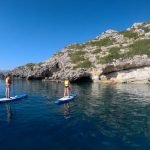
Crete is a beautiful Greek island known for its stunning beaches, rich history, and delicious cuisine. However, driving on the island can be an adventure in and of itself. Here are some things to keep in mind if you’re planning on driving in Crete.
Things to Know
Drive on the Right In Greece, as in many other countries around the world, drive on the right side of the road.
Seatbelt Usage Seatbelt use is mandatory for all occupants of the vehicle, and actually the one of the easily punishable offenses.
Alcohol Limits Having a blood alcohol content of only 0.05 percent (equivalent to consuming two beers) will categorize you as legally intoxicated, as opposed to the 0.08 percent threshold of countries like the United States and England. We would highly advise you not to drink while driving.
Minimum Driving Age The minimum driving age is 18, but rental companies often require drivers to be at least 21 with at least 1 year of driving experience.
Speed Limits Urban speed limits are typically 50km/h, but they can be lower in specific areas. Always check the road signage for the applicable speed limit.
Must-Carry Items Essential items to carry in your vehicle include a reflective warning triangle, fire extinguisher, and a first aid kit.
Emergency Numbers In case of an accident or emergency, dial the European emergency number 112. The Greek direct emergency numbers are 100 for Police, 166 for an Ambulance and 199 for Fire Department.
Respect Traffic Signs and Signals Respect all traffic signs, signals, and road markings. Pay attention to specific rules and regulations, especially in urban areas.
Use of Mobile Phones It is strictly prohibited to use a mobile phone while driving unless you have a hands-free device.
Parking Regulations Adhere to parking regulations to avoid fines. In some areas, there may be designated parking zones or restrictions.
Toll Roads There are NO toll roads in Crete so you don’t have to be concerned about this.
Motorcycle Helmets If you’re riding a motorcycle, both the driver and passenger must wear helmets.
Remember that these rules provide a general overview, and it’s essential to familiarize yourself with the specific driving regulations in the region you are visiting. Always drive defensively, be aware of your surroundings, and respect local traffic laws.
Advice
First and foremost, you will need a valid driver’s license to drive in Crete. If you’re coming from the US or Canada, you’ll need an International Driver’s Permit (IDP) in addition to your regular driver’s license. It’s important to note that driving in Crete is on the right side of the road, as it is in most of mainland Europe.
If you’re planning on driving in Crete, it’s a good idea to familiarize yourself with the road signs and traffic laws before you go. There are a few differences from what you might be used to, such as the use of roundabouts instead of four-way stops, so it’s important to be aware of these differences to stay safe on the road.
The roads in Crete can be narrow and winding, especially in the mountainous areas of the island. If you’re not used to driving on narrow roads, it can be a bit nerve-wracking at first. It’s important to take your time, be patient, and always be aware of your surroundings. You may also encounter livestock or pedestrians on the road, so it’s important to be alert and prepared to slow down or stop if necessary.
Another thing to keep in mind is that the speed limit on the island is often lower than what you might be used to. This is especially true in residential areas and near schools, where the speed limit may be as low as 20 km/h. Pay attention to speed limit signs and be prepared to slow down accordingly. The speed limit on the highway is 90 km/h unless indicated but the speed limit signs. Parts in Heraklion can go up to 110 km/h on the signs.
Useful Tips
1. Double check when crossing: When driving through a traffic light, even though you might have green, Greek drivers have the habit of crossing the red light. Make sure you double check the road when you have green before going, especially if you are first to go and make sure no car is coming from another direction.
2. Shoulder or Emergency Lane: It’s essential to understand that when you’re on the highway/motorway, it’s expected that you drive partially on the wide emergency lane to facilitate other vehicles in overtaking you. This is a very common practice in Crete and you will not be fined for crossing to the emergency lane.
3. Be prepared for narrow roads: As I mentioned earlier, many of the roads in Crete are narrow and winding. If you’re not used to driving on narrow roads, it can be helpful to practice in a less busy area before tackling the more challenging routes.
4. Take note of the road conditions: Some of the roads in Crete can be quite rough, with potholes, loose gravel, or uneven surfaces. It’s important to pay attention to the road conditions and adjust your driving accordingly.
5. Be mindful of other drivers: As with driving in any unfamiliar place, it’s important to be calm with other drivers who may not be as patient on the road. Locals are sometimes aggressive or impatient drivers, so always be courteous to other drivers.
6. Take frequent breaks: If you’re planning on driving long distances, it’s important to take regular breaks to stretch your legs and rest your eyes. Not only will this make the drive more comfortable, but it will also help you stay alert and focused on the road.
7. Use your horn sparingly: Honking your horn in Crete is generally seen as an aggressive gesture, so it’s best to use it sparingly. If you need to alert another driver of your presence, a quick beep is usually sufficient.
8. Avoid driving at night: While it’s certainly possible to drive at night in Crete, it can be more challenging due to the narrow roads and lack of streetlights in some areas. If possible, try to plan your driving during daylight hours.
9. Use a GPS system: Having a GPS system (in the car or Google Maps) can be extremely helpful when driving in Crete, especially if you’re not familiar with the island. Make sure to rent a car with a reliable GPS system or bring your own navigation device.
10. Watch out for motorcycles and scooters: Motorcycles and scooters are a popular mode of transportation in Crete, especially during the summer months. Keep an eye out for them and give them plenty of space on the road.
11. Check the weather forecast: Crete can experience sudden weather changes, especially during the winter months. Before heading out on a long drive, check the weather forecast to make sure you’re prepared for any conditions you might encounter.
12. Keep your documents handy: Make sure you have your driver’s license, rental agreement, and any other necessary documents with you in the car at all times. You may be asked to show these documents at police checkpoints or if you’re involved in an accident.
Parking
In the larger cities like Heraklion and Chania, street parking can be difficult to find, especially in the tourist areas. However, there are usually parking lots or garages available for a fee, but generally it is very affordable as low as 1 euro an hour. In smaller towns and villages, street parking is often easier to find, but be mindful of any signs indicating restricted areas or time limits.
If you’re visiting during the peak summer season, be prepared for crowded parking lots and limited spaces. Consider arriving early or taking public transportation to avoid the stress of searching for a spot. With a little planning and patience, parking in Crete can be manageable. And once you’re parked, you can enjoy all that this beautiful island has to offer.
Here are the best parking places to park your car in the cities of Chania, Rethymno, Heraklion and Agios Nikolaos.
Driving in Crete can be a bit of a challenge, but with a little bit of preparation and patience, it can be a great way to explore the island at your own pace. Just remember to take your time, be aware of your surroundings, and always follow the rules of the road. Happy driving!













